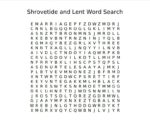
Today is Ash Wednesday, the first day of Lent, which in Tudor times was a time of fasting and prayer.
But how did Tudor people mark Ash Wednesday and Lent? What else did they do?
[Read More...]
Today is Ash Wednesday, the first day of Lent, which in Tudor times was a time of fasting and prayer.
But how did Tudor people mark Ash Wednesday and Lent? What else did they do?
[Read More...]
Advent and Lent were fasting periods, times when a medieval and Tudor person was supposed to abstain from eating meat.
However, the Tudors did get rather creative and cheated.
Find out more in this talk…
[Read More...]
During Lent, the time leading up to Easter, animal products such as meat, eggs, butter and cheese, were forbidden, so more fish was eaten, just as it was eaten on Fridays and other religious days.
But what kinds of fish were enjoyed in medieval and Tudor times, and how did those clever Tudors get round some of the rules and enjoy some meat?
Here’s a word search puzzle to test your knowledge of medieval and Tudor “fish”.
[Read More...]
This week’s brain teaser is a word search testing your knowledge of Shrovetide and Lent, and the traditions associated with this time of the year. As always, the answers are all on the site. Good luck.
Simply click on the link or image below to open the word search and print out.
[Read More...]
Lent started this week so I thought I’d test your knowledge of Lent and how it was marked during Tudor times. If you get stuck, you can listen to Claire’s video talk on Lent.
Click on the link or the picture of the puzzle below to open the puzzle and to print it out. Good luck!
[Read More...]
In this week’s Claire Chats video talk, I look at what Shrovetide and Lent are, and how they were marked in the medieval and Tudor period, and discuss some of the traditions associated with them.
[Read More...]
Today is Shrove Tuesday, the final day of Shrovetide and the last opportunity to use up forbidden foods and to have some fun before the abstinence of Lent – well, for some people anyway!
At the Tudor court, Shrovtide was marked with entertainment such as jousting, pageants, music and masques, plus lots of feasting. Alison Sim, in her book “Pleasures and Pastimes in Tudor England”, describes one Shrovetide entertainment, “threshing the cock”, which consisted of tethering a cock and then people trying to kill it by throwing things at it. A prize was given to the person who killed it. Sim also writes of how “sometimes the cock was buried with just its head sticking out of the ground and then blindfolded people would try to kill it with a flail.” I’m so glad that we don’t do that today! Awful!
[Read More...]
Today is both Ash Wednesday and St David’s Day!
Ash Wednesday was the first day of Lent and was a day of penitence. Before the Reformation banned the practice, priests would bless ashes, which were traditionally made from burning the previous year’s Palm Sunday ‘palms’, mix them with holy water and then mark the congregation’s foreheads with the sign of the cross in ash. As the priest did this, he would say “Remember, man, that thou art dust and to dust thou shalt return.”
[Read More...]
Today is the second of the three days that make up Shrovetide and it’s Collop Monday.
Collop Monday was the traditional day to use up any meat you had in the house before the fasting of Lent began. Collops were pieces of fried or roasted meat.
[Read More...]
Lent was, and is, the lead-up to Holy Week and it lasted six and a half weeks. In Tudor times, it was a period of fasting, a time when meat, eggs, cheese and sexual relations were forbidden. Prior to this fasting was a time of celebration, Shrovetide, which began on the seventh Sunday before Easter, a day known as Shrove Sunday. The word “Shrove” came from “shriving”, the confession of sins and the receiving of absolution for them.
[Read More...]